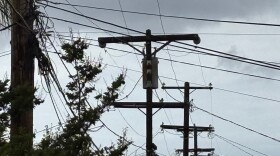Extreme temperatures are coming back to the Imperial Valley and the desert regions of San Diego this weekend as a heat dome builds across the Western United States.
With those spiking temperatures come the danger of heat-related deaths and illnesses. Heat waves are one of the deadliest kinds of extreme weather, killing more than 1,200 Americans every year, according to the Centers for Disease Control.
But one San Diego researcher who studies heat also has a hopeful message: all of those deaths can be averted.
Resources for staying cool during hot weather
- Cool Zones: San Diego County libraries, community centers and more that offer free access to AC.
- City of San Diego pools hours and locations.
- Get a free fan by contacting San Diego County's Aging & Independence Services at 800-339-4661.
- Imperial County's list of Cool Centers and Hydration Stations.
“Any death due to heat is preventable,” said Tarik Benmarhnia, who leads the Scripps Institution of Oceanography’s Climate Epidemiology Lab. “We can do better.”
What makes heat so dangerous?
The greatest physical danger during a heat wave comes from the human body’s instinct to cool it down, Benmarhnia said. As it heats up, the body will start pumping water outward towards the skin. The goal is to release that water as sweat, which carries large amounts of heat with it as it evaporates off the skin.
It’s an effective tactic in the beginning. But if hot conditions continue, the body’s cooling measures will begin to strain the heart, forcing it to work harder to keep blood pumping. The loss of water can also lead to a cascade of issues in the brain and other vital organs. Eventually, the walls of your organs can start to leak.
“The longer you get exposed, the more complex and severe the complication can be,” Benmarhnia said.
Heat-related illnesses have been climbing in the Imperial Valley since the beginning of May, according to the Imperial County Public Health Department. One week in June saw around 20 reported cases, including several deaths.
This weekend, the National Weather Service is expecting temperatures to spike to between 110 and 117 degrees from Borrego Springs all the way to Palm Desert and Yuma.
This year has already seen record-breaking temperatures in parts of Southern California. Much of the San Diego and Imperial region has already been hotter than normal. And last month, Palm Springs hit 124 degrees — one of the highest temperatures the state has ever recorded outside of Death Valley.
What can we do to stay safe?
When it comes to staying safe, Benhmarnia pointed out that much of that responsibility falls to local governments and community organizations, who can do things like maintaining public cooling centers and having a resilient health care system.
On a personal level though, he said the first thing to consider is whether you have any conditions that make you more vulnerable to a heat-related illness.
People with diabetes, heart and lung conditions and cognitive issues are especially at risk, he said. That’s because hot conditions will add new strain on those internal systems. Young children and pregnant people also need to be especially careful.
For people in those categories, he advised staying in a cool place, limiting physical movements and drinking plenty of water. Benmarhnia also said it is often a good idea to check in with your doctor if you have a medical condition, especially if you are taking any medications.
Some of the key warning signs of heat-related illnesses to look out for include moist or pale skin, excessive sweating, difficulty breathing and dizziness or confusion.
If you start noticing any of those symptoms, Benmarhnia said, air conditioning is one of the most effective ways to cool down. You should try to spend some time at a local cooling center or a nearby library or department store.
Even a few hours in a cool place can make a difference if you have to go back out into the heat, according to the CDC.
You can also cover your head with a wet towel and use a fan to cool down, although Benmarhnia said older people should be more cautious about relying on that tactic since fans can dry out their skin.
Finally, one of the most important things you can do is check on your loved ones and anyone you know who lives alone.
Many people who die during heat waves are isolated and have pre-existing conditions. Benmarhnia said checking in can be a powerful way to prevent that.






